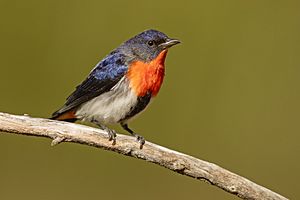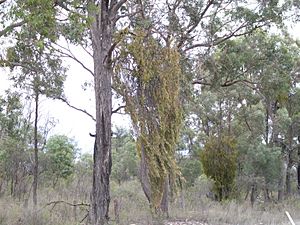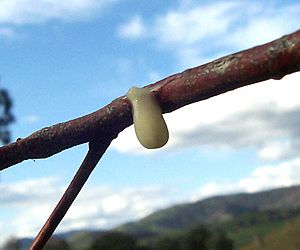Mistletoebird facts for kids
Quick facts for kids Mistletoebird |
|
|---|---|
 |
|
| Male | |
| Conservation status | |
| Scientific classification | |
| Genus: |
Dicaeum
|
| Species: |
hirundinaceum
|
 |
|
| Distribution map of Dicaeum hirundinaceum hirundinaceum in red, (top-centre:) D. h. keiense in green, D. h. ignicolle in purple, and D. h. fulgidum in orange. | |
The mistletoebird (Dicaeum hirundinaceum) is a small, colorful bird. It is also called the mistletoe flowerpecker. These birds live in most parts of Australia, but not in Tasmania or the very dry deserts. They also live in the eastern Maluku Islands of Indonesia.
Mistletoebirds mainly eat berries from a plant called mistletoe. Mistletoe is a parasitic plant, meaning it grows on other trees. The mistletoebird helps spread mistletoe seeds through its digestive system. This makes them very important for the mistletoe plant.
Contents
Mistletoebird Facts
Bird Family and History
The mistletoebird belongs to the flowerpecker family. There are 44 different types of flowerpeckers. Scientists think flowerpeckers are closely related to sunbirds. Both families of birds likely developed around 20 to 30 million years ago.
Sunbirds are mostly found in Africa and Asia. Flowerpeckers live throughout Asia. The mistletoebird arrived in Australia more recently. It started living there about two million years ago.
Mistletoe Specialists
The mistletoebird is a "mistletoe-feeding specialist." This means it mostly eats mistletoe berries. Many other bird families have also developed this special diet.
Early studies thought mistletoe and mistletoebirds needed each other equally. However, mistletoe has been in Australia for a long time. Mistletoebirds arrived much later. This means other birds, like honeyeaters, spread mistletoe seeds before. So, while the mistletoebird needs mistletoe, the mistletoe plant does not depend only on the mistletoebird.
Bird DNA and Relatives
Scientists use special methods to study bird families. They look at the birds' DNA. This helps them understand how different flowerpeckers are related.
Most flowerpeckers have different colors for males and females. They also have strong beaks. Studies of their DNA show that the mistletoebird is most closely related to the red-capped flowerpecker.
The name hirundinaceum comes from the word for swallow (Hirundo). This is because the mistletoebird has long, pointed wings, like a swallow.
Mistletoebird Types
There are four types, or subspecies, of mistletoebirds. They live in different places and have small differences in their feathers. These differences are mostly seen in the males:
- Dicaeum hirundinaceum hirundinaceum — Found in Australia. Males have a lot of red on their throat and chest. Their sides are grey.
- Dicaeum hirundinaceum keiense — Found in the Watubela archipelago, Indonesia. Males have less red on their chest.
- Dicaeum hirundinaceum ignicolle — Found in the Aru Islands, Indonesia. Their sides are yellow-buff.
- Dicaeum hirundinaceum fulgidum — Found in the Tanimbar Islands, Indonesia. Their sides are buff, and they have less red on their chest. Their throat is pale buff.
Mistletoebird Appearance
The mistletoebird is a small bird. It is about 9 to 10 centimeters (3.5 to 4 inches) long. It weighs about 7.5 to 11 grams (0.26 to 0.39 ounces).
The male mistletoebird is shiny blue-black on its back. It has a bright red chest and a little red under its tail. A black stripe runs down its white belly. The female is dark grey on top. She has a white throat and light grey underparts. She only has a small touch of pinkish-red under her tail.
Both males and females have black eyes, beaks, and legs. Their beak is slender and slightly curved. Young birds look like the female. But they have an orange-pink beak instead of a black one.
Mistletoebirds in the north are smaller. Females in the north also have lighter colored underparts. Those in the south are darker.
The mistletoebird has long, pointed wings. Its tail is short and square with a small notch. They usually fly swiftly. You often see them flying high in the trees. When they perch, they usually sit upright. But they might sway when they are worried.
They make many different sounds. Their most common call is a short, high-pitched tzew or dzee whistle. They often make this sound while flying. When perched, they might whistle wissweet wissweet many times.
Mistletoebird Behavior
Where Mistletoebirds Live

Mistletoebirds are nomadic. This means they move around. Their movements depend on where mistletoe berries are ripe. They mostly live in forests and woodlands. These areas often have Eucalyptus trees. They can be found from dry inland areas to coastal rainforests.
They do not like high-altitude areas in winter. This is because they get very cold. Mistletoebirds prefer older forests. These forests have larger trees that are more likely to have mistletoe.
There are about 100 types of mistletoe in Australia. A common type in dry areas is the grey mistletoe. Mistletoe plants get water and nutrients from their host tree. But they make their own food using photosynthesis. So, they are called 'half parasitic'. Mistletoe is common in mainland Australia, but not in Tasmania.
Other fruit-eating birds, like honeyeaters, eat more insects. They travel further to find food. This helps spread mistletoe seeds over long distances. Mistletoebirds usually stay in areas with lots of mistletoe.
Mistletoe plants also help create rich biodiversity. Many animals and plants live in areas with mistletoe. The thick mistletoe bushes offer a cool and safe place for birds to rest and nest. One study found that 217 types of Australian birds nested in mistletoe. This includes the mistletoebird itself.
What Mistletoebirds Eat
The mistletoebird is a specialist frugivore. This means it mainly eats fruit. It mostly eats mistletoe berries. They spend about 25% of their day in summer looking for food. In winter, it's about 29%. They eat more fruit in winter to stay warm.
Mistletoe fruit makes up 85% of their diet. They also eat some insects and nectar. Another bird, Pesquet's parrot from New Guinea, is also a fruit specialist. It mainly eats strangler figs.
Mistletoe plants produce few fruits over a long time. This stops birds that are not specialists from eating all the berries. Specialist fruit-eating birds eat a lot of fruit. This diet is rich in carbohydrates but low in protein. To get enough protein, especially for laying eggs or growing new feathers, mistletoebirds must eat many mistletoe fruits.
How Mistletoebirds Eat and Spread Seeds
The mistletoebird has a special digestive system. Its stomach is small and muscular. Its digestive tract is short. This allows mistletoe seeds to pass through quickly. This means the seeds are not broken down much.
Other birds, like the spiny-cheeked honeyeater, have a more complex digestive system. Seeds take longer to pass through them. They also get more broken down. Mistletoe seeds pass through a mistletoebird in 4 to 25 minutes. One study showed that seeds from mistletoebirds grew much better than seeds from honeyeaters.
The mistletoebird's digestive system is very straight. This helps many berries pass through fast. For example, a mistletoebird's gizzard is about 4.3 mm long. A similar-sized insect-eating bird, like the inland thornbill, has a gizzard about 13.5 mm long. The mistletoebird's small intestine is 55 mm long. The thornbill's is 88 mm long.
The mistletoebird also has a large mouth opening, called a gape. This helps it swallow mistletoe fruits. These fruits are quite large for such a small bird. They are about 12 mm long and 7 mm wide.
Mistletoebirds are very good at spreading seeds. They often perch along a branch when they poop. This makes the sticky seeds fall directly onto the branch. This is where the mistletoe needs to grow. Seeds from honeyeaters fall more randomly. The mistletoebird's poop is also stickier. This helps the seed stick firmly to the host tree branch.
Mistletoebird Reproduction
Mistletoebirds have special courtship dances. The male sways from side to side. He flutters his wings and flicks his tail. This shows off his red feathers. The female flies to a nearby branch and flutters her wings. The male then flies to her, they mate, and fly off together.
Mistletoebird pairs build their nests alone. They can raise up to three groups of young each season. The breeding season is usually from August to April. It depends on the area in Australia. It also matches when mistletoe has fruit.
Nests can be found in many plants. They are often in eucalyptus, mistletoe, and acacia trees. The nest hangs from a thin branch. It is hidden among the leaves. The nest is shaped like a pear with a slit on the side for an entrance. It is made of plant fluff, wool, and spider webs. The outside is covered with dry leaves, bark, and lichen.
The female builds the nest. The male sometimes helps. The female sits on the eggs. But males have been seen sitting on the nest when the female is away. She lays three or four white, oval eggs. Each egg is about 17 x 11 mm. The eggs hatch in 10 to 12 days. The young birds stay in the nest for about 15 days.
Both parents feed the young, but mostly the female. Young birds first eat insects. Then, mistletoe berry pulp is slowly added to their diet. By the time they are ready to leave the nest, mistletoe pulp makes up 80% of their food. Both parents remove the waste from the nest.
Other Mistletoebird Facts
A mistletoebird in southern Queensland lived for at least 9 years. Scientists know this because they put a band on its leg.
Mistletoebirds can copy the sounds of other birds. Both males and females do this in all seasons. They have been heard mimicking over 25 different bird species.
Some animals eat mistletoebird nestlings. These include the grey shrike-thrush, pied butcherbird, pied currawong, and Australian raven. Some cuckoo species, like Horsfield's bronze cuckoo and the fan-tailed cuckoo, lay their eggs in mistletoebird nests. This is called brood parasitism.
Mistletoebirds and People
In the past, there was a natural balance between mistletoe and its host trees. But when people cleared too much land for farms and towns, this balance was disturbed. In some areas, there was too much mistletoe. This harmed or killed the host trees. In other areas, there was no mistletoe at all.
When there was too much mistletoe, people tried to get rid of the birds that spread it. They thought the mistletoebird was causing the problem. In the 1930s, one farmer claimed to have killed over 1200 mistletoebirds. However, people no longer actively hunt these birds.
See also
 In Spanish: Picaflores golondrina para niños
In Spanish: Picaflores golondrina para niños






